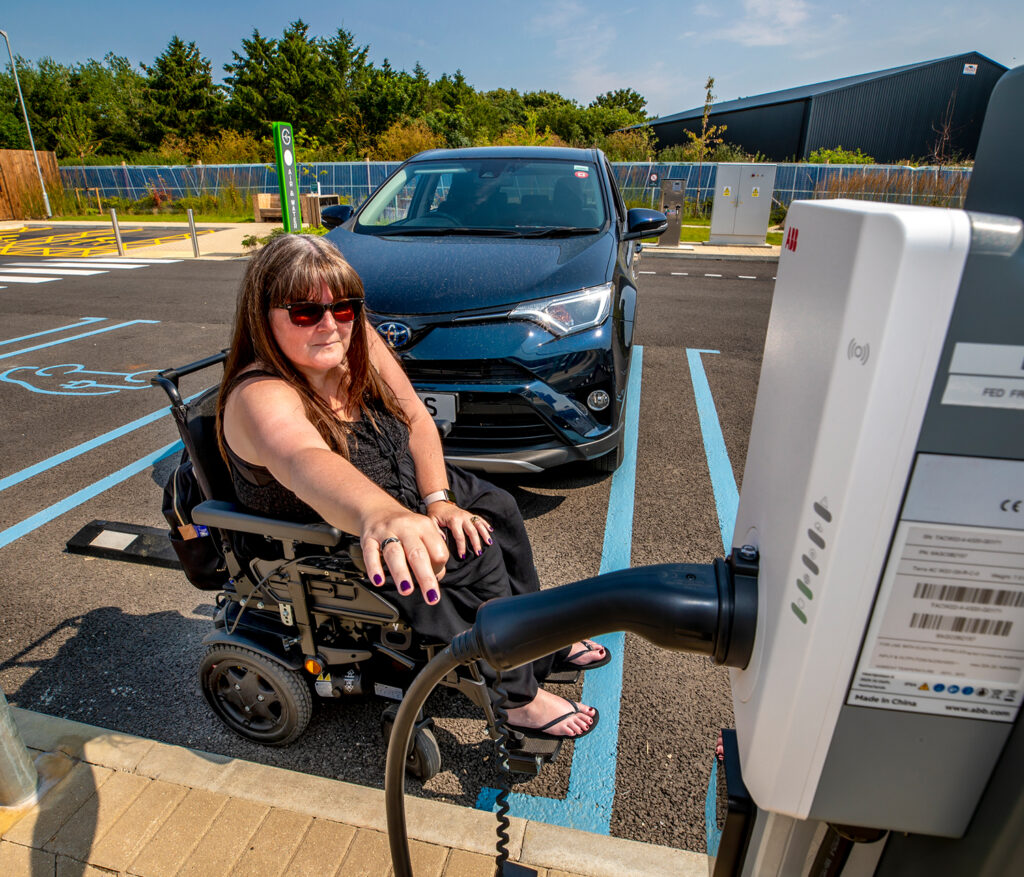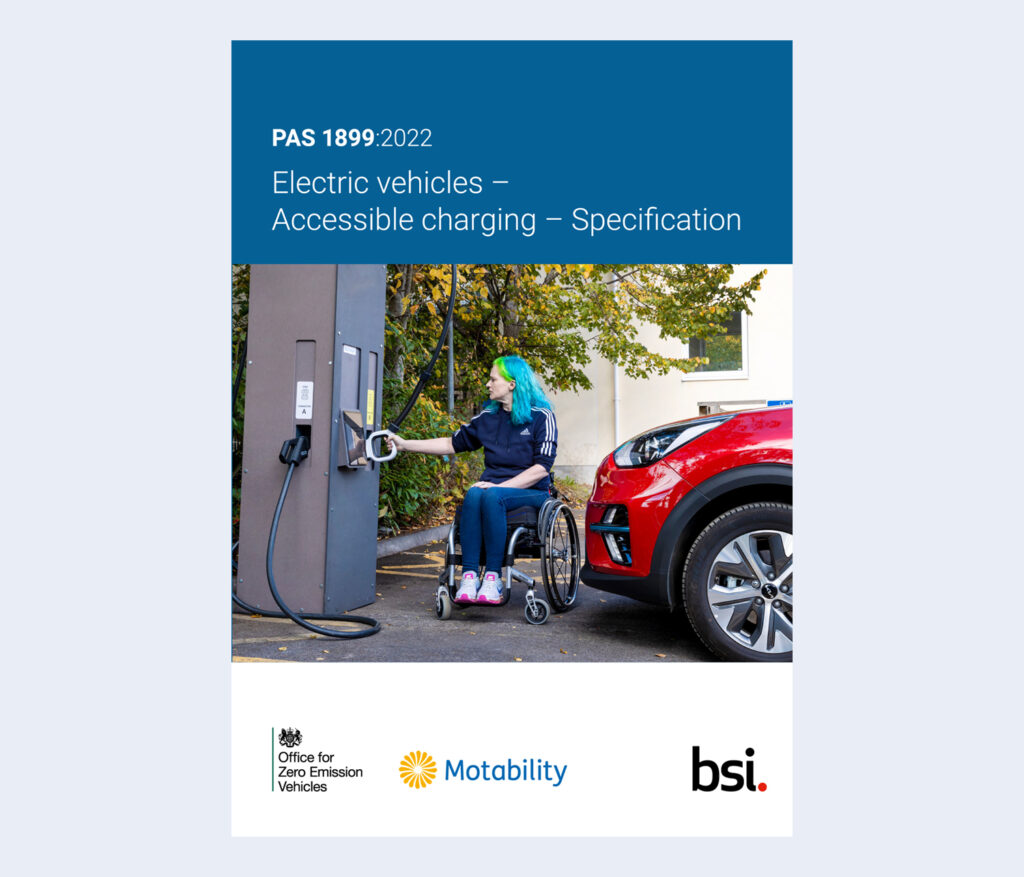Charging unit position and location
The way a charging unit is positioned, and the location of a charge point in relation to its surroundings, can affect the user’s charging experience.

Kerbs and level changes
People should be able to exit their vehicle and walk or wheel easily onto pedestrian walkways from the charging point, so make sure level access or nearby dropped kerbs are available.
“I can’t transfer from car into wheelchair when there is a high kerb; I look for level access onto the rest of the site (so no steps, kerbs, gravel, cobbles etc) – I don’t want to be landlocked at the charger!”

All parts of the unit should be reachable from the ground level that the person is standing or sitting on, once the unit is in its installed position. The accessibility of a well-designed charging unit can be undermined by placing it in a higher position than it was designed for, inadvertently putting some of the features out of reach of some users. See our See reach and use page for more about making charging units accessible.
“The machines on kerbs are too high up to reach from my wheelchair”
Setting a unit too high up or too far back on a step can restrict who can use it, particularly as the raised surface can require the user to move onto a raised surface consisting of gravel, mud or bark chippings.
Bear in mind some features on the side of a unit may be harder to see and reach than those on the front, so consider the whole setting when positioning the charging unit.
“The raised kerb doesn’t give much space to stand around the charger, but I need to step up to reach the cable – then I worry about stepping backwards off the kerb without noticing the level change, and falling”
Obstructions at the charge point
Measures that are put in place to protect the charging unit, such as bollards and raised concrete plinths, can reduce access, so consider the positions of these carefully so that they do not prevent someone reaching or using parts of the charging unit, or look at alternative solutions.
Remember that some wheelchairs and scooters have large footplates or front or rear parts that may limit a person’s reach.
Ensure that there is space for people using different mobility aids to approach the charging unit and position themselves so they can see reach and use all parts of it. See our See reach and use page for more about making charging units accessible.
Other obstructions such as poorly positioned bins and signs can also prevent access to otherwise accessible charging units.
“I don’t approach it straight on, I position myself diagonally in my wheelchair so I can get closer to it with my right hand”

Ground conditions
Think about the ground surface around the charging unit. Level, smooth ground is important because people with mobility issues, whether walking or wheeling, may find sloping ground and uneven ground such as gravel, potholes or mud difficult or impossible to move around on, and they may be more likely than other people to trip or fall.
“Lots of car parks are on a gradient. I park with the bonnet pointing downhill so that my wheelchair is trapped by the open car door as I assemble it and cannot roll away”
Once a person has arrived at a charging unit, make sure they do not need to move onto muddy, grassy, or uneven ground to reach the parts of the charging unit.
“I hate it when I have to stand on wet grass to charge”
Nearby amenities
People may need or want to be close to shops, toilets, cafes or other amenities while they charge their vehicle. This can be particularly important for disabled users with toileting or other needs, and convenient for anyone to save time moving from the charging point to the amenities.
“The chargepoints at my nearest motorway services are near the shops and toilets, which is what I need – I’ll always choose those, even if I have to drive further to find them”


Shelter and lighting
Consider providing shelter over the charging unit to protect people from hot or wet weather.
This can be more important for disabled people because they may take longer than average to get in and out of the vehicle or to wait for electric powered doors to open and close, as well as to manoeuvre around the vehicle and manage the charging process. See our page about adapted vehicles for disabled people for more details.
Lighting that illuminates the usable parts of the charging unit means that the user can see what they are doing, and situating the charging unit in a well-lit area can help people to feel safe in the dark.
“There is no light in my car’s charging socket, so in the dark I use my 30-seconds of headlights that stay on after I get out of the car to rush to plug in the cable”

Trees and shrubs
Finally, remember that although foliage is often used to make car parks more green and pleasant, untrimmed shrubs and bushes can make charging unpleasant or impossible for some people, particularly in wet weather.
“I get wet where there are bushes close to the charge point and it has been raining”
Careful planning and maintenance of green areas can help to avoid these issues.

The new standard for accessible EV charging
Take a look at the requirements and recommendations set out in PAS 1899:2022 Electric vehicles – Accessible charging – Specification
Explore our case studies
Our case studies have been drawn together from first-hand accounts that were shared with us by disabled people and those close to them. Each story is made up of insights from several individuals, to share as much of our research as possible and to illustrate the impact of good and bad design on real people.
Download the design guidance
Our design guidance covers signage and information, the built environment and charging an electric vehicle.



